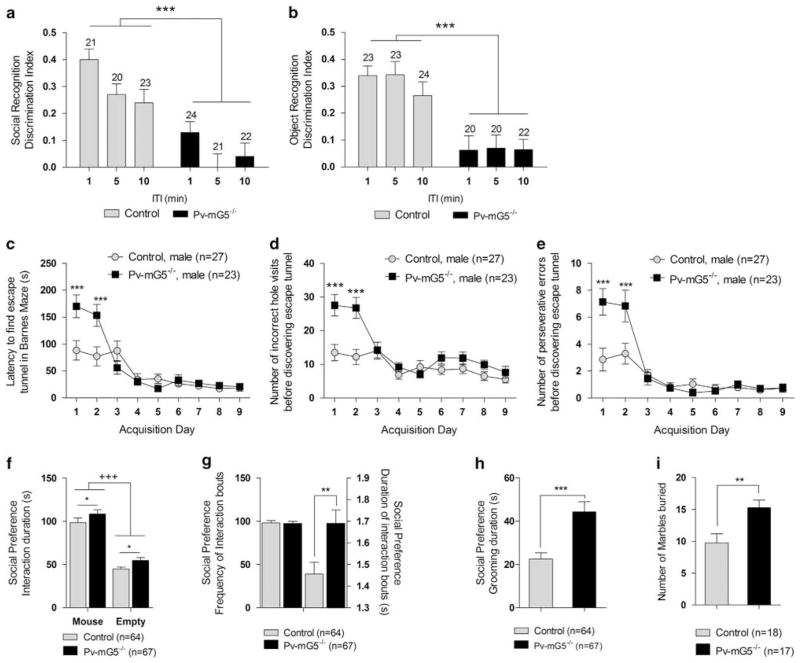Figure 3.
Postnatal metabotropic glutamate receptor 5 (mGluR5) ablation impaired recognition memory and increased repetitive behaviors. (a) Performance in the social recognition task was impaired in Pv-mG5−/− mice, with the ability to discriminate between a novel and familiar mouse abolished (genotype: F(1,119) = 45.61, P <0.001). Social discrimination was also sensitive to an increase in inter-trial interval (ITI), independent of genotype (ITI: F(2,119) = 5.43, P <0.001), with superior performance after a 1 min ITI (1 vs 5 min, P <0.01; 1 vs 10 min, P <0.05; data not shown). (b) Object recognition was impaired in Pv-mG5−/− mice (genotype: F(1,120) = 44.98, P <0.001), with no effect on any other variables. (c) The latency to find the escape tunnel was increased (day × genotype: F(8,384) = 6.02, P <0.001) during days 1 and 2 (P <0.001) (d), coupled with an increase in the number of errors made (day × genotype: F(8,384) = 4.41, P <0.001) on days 1 and 2 (P <0.001). (e) These effects are attributable to the increased perseverative responding (day × genotype: F(8,384) = 4.16, P <0.001) that was also evident on days 1 and 2 (P<0.001). (f) Sociability was preserved in mice, and both groups spent more time interacting with the novel mouse compared with the empty cup (side: F(1,127) = 206.63, P <0.001). The analysis of variance (ANOVA) also indicated that Pv-mG5−/− mice spent more time interacting with cups, independent of side (genotype: F(1,127) = 6.25, P <0.05). (g, left) There was no difference in the frequency of interactions initiated, (g, right) but the duration of each bout was increased in Pv-mG5−/− mice (genotype: F(1,127) = 9.03, P <0.01). (h) The duration of grooming was increased in Pv-mG5−/− mice during the assessment of sociability (genotype: F(1,127) = 14.56, P <0.001). (i) The increased number of marbles buried further indicates that repetitive behavior was increased in Pv-mG5−/− mice (genotype: F(1,31) = 8.99, P <0.01). Numbers over bars represent n numbers. Performance was analyzed with repeated-measures ANOVA followed, when appropriate, by Fisher’s LSD post hoc test. Light bars reflect control mice, and dark bars reflect Pv-mG5−/− mice. Asterisk denotes difference between control and Pv-mG5−/− mice (*P<0.05, **P<0.01). Plus denotes effect side (+++P<0.001). Bar graphs depict means ± s.e.m.

